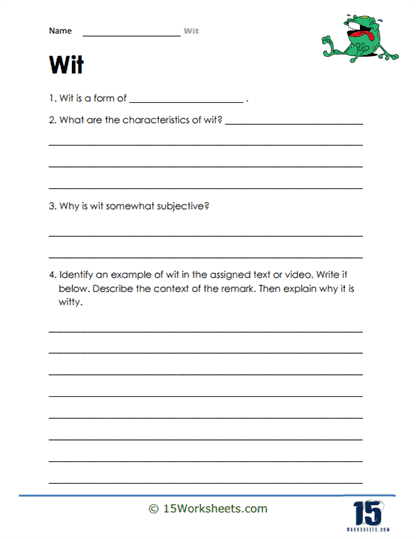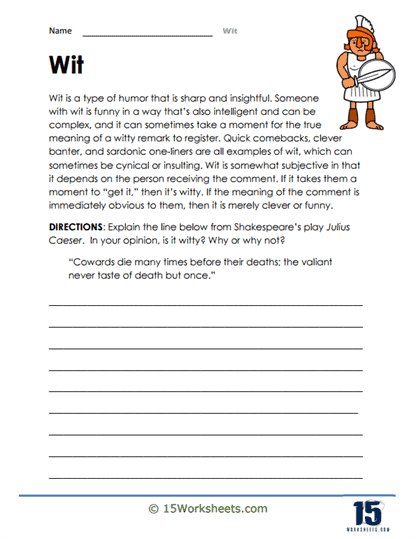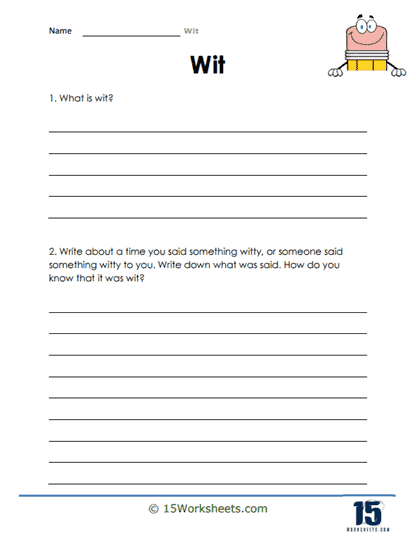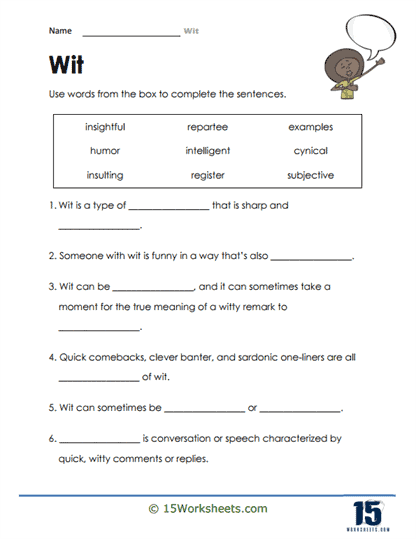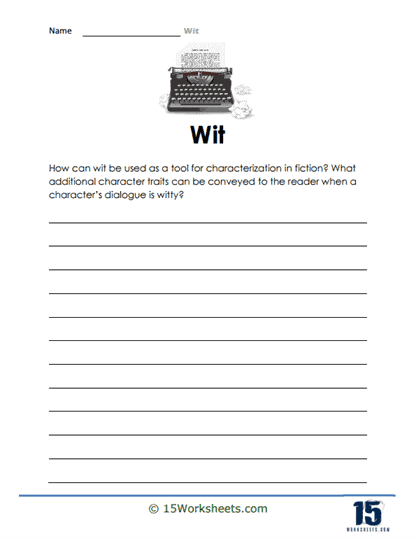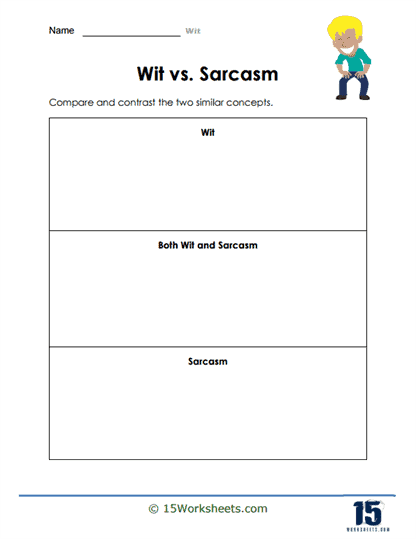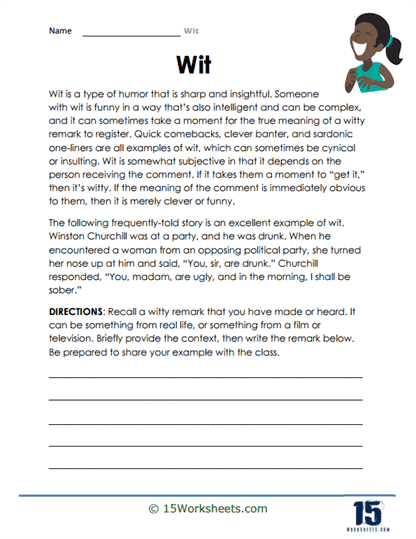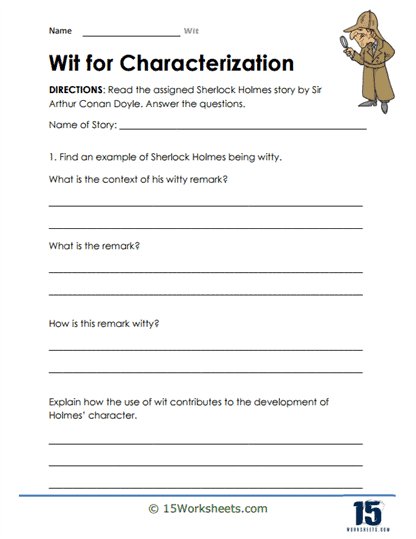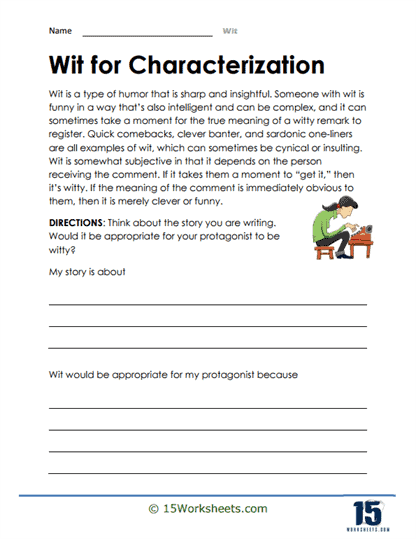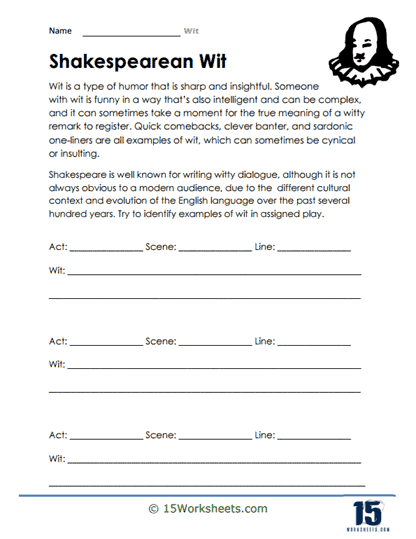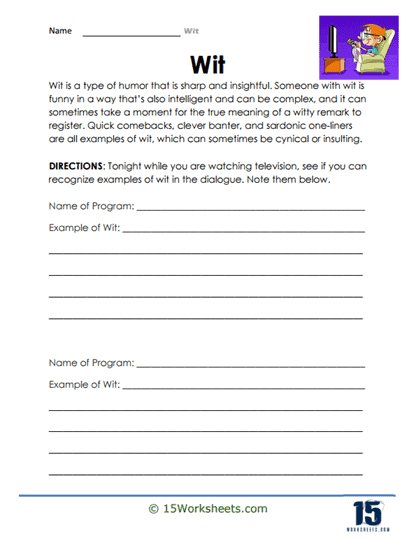Wit Worksheets
About These 15 Worksheets
Wit Worksheets serve as an educational tool designed to enhance students’ understanding and skills in language arts and reading. These worksheets encompass a variety of exercises tailored to address different aspects of language learning, including grammar, vocabulary, comprehension, and creative writing. By engaging with these exercises, students can significantly improve their language arts and reading skills, gaining a deeper understanding of language mechanics, enriching their vocabulary, enhancing their reading comprehension, and fostering their creative and critical thinking abilities.
Through a wide range of exercises focused on vocabulary development, grammar and punctuation, reading comprehension, writing and creative expression, and critical thinking and analysis, these worksheets provide a structured approach to improving language skills. Regular practice with Wit Worksheets can significantly enhance students’ understanding of language arts, improving their communication skills, reading proficiency, writing ability, and analytical thinking. This not only contributes to academic success but also prepares students for future challenges, making Wit Worksheets an invaluable resource in the educational journey.
Vocabulary Development
One of the core components of these worksheets is vocabulary development exercises. These exercises are designed to expand students’ lexicon, introducing them to new words and phrases. Activities might include matching words with their definitions, using new vocabulary in sentences, synonym and antonym identification, and context clues exercises. Through regular practice with these types of exercises, students can enhance their ability to understand and use complex vocabulary, aiding both their comprehension and expression in language arts.
Grammar and Punctuation
Grammar and punctuation exercises form another vital aspect of Wit Worksheets. These exercises focus on teaching students the rules of language structure, including sentence construction, verb tenses, subject-verb agreement, punctuation usage, and the correct use of different parts of speech such as nouns, verbs, adjectives, and adverbs. By completing these exercises, students learn to write more clearly and accurately, improving their written communication skills and their ability to edit and revise their work.
Reading Comprehension
Reading comprehension exercises are a key feature of Wit Worksheets, designed to improve students’ ability to understand and interpret written material. These exercises often involve reading passages followed by questions that test understanding of the text. Questions may focus on main ideas, supporting details, inferences, and the author’s purpose. There may also be exercises that require students to compare and contrast texts, identify cause and effect relationships, and understand the use of figurative language. Practicing these exercises helps students develop critical thinking skills and a deeper understanding of various texts, enhancing their overall reading proficiency.
Writing and Creative Expression
Wit Worksheets also include exercises focused on writing and creative expression. These activities encourage students to engage in creative writing, such as composing stories, poems, or descriptive paragraphs. There may also be prompts for opinion pieces or persuasive essays, where students must articulate their viewpoints clearly and convincingly. Through these writing exercises, students can explore their creativity, improve their writing style, and develop their ability to organize thoughts coherently. This not only bolsters their writing skills but also enhances their ability to express themselves creatively and persuasively.
Critical Thinking and Analysis
Exercises that foster critical thinking and analysis are an essential part of Wit Worksheets. These exercises might include analyzing characters, themes, and plots in literature, evaluating arguments in persuasive texts, or interpreting the use of language and rhetorical devices in various writings. By engaging in these analytical activities, students learn to think more deeply about the texts they read, developing their ability to analyze and critique written material critically. This skill is invaluable not only in language arts but across all areas of study.
Benefits of These Worksheets
These types of worksheets offer numerous benefits to students. They enhance vocabulary and grammar skills, which are fundamental to effective communication. A robust vocabulary and a solid understanding of grammar rules enable students to express themselves more clearly and understand the nuances of language better.
These worksheets improve reading comprehension skills, helping students to become more proficient readers who can understand and engage with a wide range of texts. This is crucial not only for academic success but also for lifelong learning and personal growth.
The focus on writing and creative expression helps students to develop their writing abilities, enabling them to convey their ideas effectively and creatively. This skill is essential for academic success and is highly valued in many professional contexts.
What is the Literary Device of Wit?
The literary device of wit is a form of intelligent humor and cleverness in the use of words and ideas, often utilized by authors to convey their messages in an engaging, thought-provoking manner. Wit involves the sharpness of intellect, a keen perception of incongruous or disparate elements, and the ability to express these observations in a concise, humorous way. Authors use wit not only to entertain but also to illuminate truths, critique societal norms, and challenge readers’ perceptions. The main defining feature of wit is its reliance on intellectual playfulness and linguistic dexterity, often manifesting through puns, paradoxes, satire, irony, and succinct aphorisms.
Characteristics of Wit
Intellectual Stimulus – Wit stimulates the intellect, requiring an understanding of nuance and subtlety in language. It often involves making connections between seemingly unrelated concepts to create insightful observations.
Brevity and Precision – Wit is marked by brevity and precision. A witty remark is typically concise, delivering maximum impact with minimal words. Despite its intellectual nature, wit is playful. It revels in the manipulation of language and ideas for humorous effect.
Surprise and Unexpectedness – Wit often involves an element of surprise or unexpectedness, where the outcome of a sentence or phrase is not what one initially anticipates.
Critical Edge – Wit frequently carries a critical edge, using humor to comment on societal norms, human behavior, or specific individuals or institutions.
Examples of Wit in Literature
Oscar Wilde’s “The Importance of Being Earnest” – Wilde’s play is a treasure trove of wit, utilizing clever wordplay, ironic situations, and paradoxical statements to critique Victorian society. For instance, the play’s famous line, “The truth is rarely pure and never simple,” exemplifies Wilde’s wit. This aphorism challenges conventional notions of truth, suggesting its complexity and the subjective nature of purity and simplicity. Wilde’s use of wit here entertains the audience while inviting them to reflect on the nature of truth and the societal penchant for oversimplification.
Jane Austen’s “Pride and Prejudice” – Austen’s novel is renowned for its wit, particularly in its commentary on marriage and social status. The opening line, “It is a truth universally acknowledged, that a single man in possession of a good fortune, must be in want of a wife,” serves as a brilliant example. This statement is witty because it flips the societal expectation on its head, humorously suggesting that it is the wealthy men who are eagerly sought after by women and their families, rather than the men themselves actively seeking wives. Austen’s wit not only entertains but also critiques the mercenary aspects of marriage and the social ladder of her time.
Mark Twain’s “The Adventures of Huckleberry Finn” – Twain’s use of wit is evident in his satirical portrayal of societal norms and human nature. One notable example is Huck’s reflection on human foolishness – “Human beings can be awful cruel to one another In the context of the novel, this observation is made with a sense of irony and simplicity that belies the depth of its critique on issues such as slavery, racism, and moral hypocrisy. Twain’s wit lies in his ability to use the innocent perspective of a child to reveal profound truths about society.
The Effect of Wit on the Reader
Wit has a multifaceted effect on the reader, engaging them intellectually and emotionally. It encourages readers to think critically, challenging their preconceived notions and inviting them to see the world through a different lens. The use of wit can also create a sense of camaraderie between the author and the reader, as the sharing of a witty observation or joke can feel like an intimate exchange. Furthermore, wit enhances the enjoyment of reading, making complex ideas or critiques more accessible and entertaining. It can serve as a vehicle for satire, allowing authors to address serious subjects in a way that is palatable and engaging, thereby broadening the reader’s perspective on important issues.

